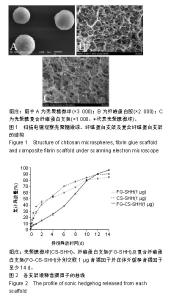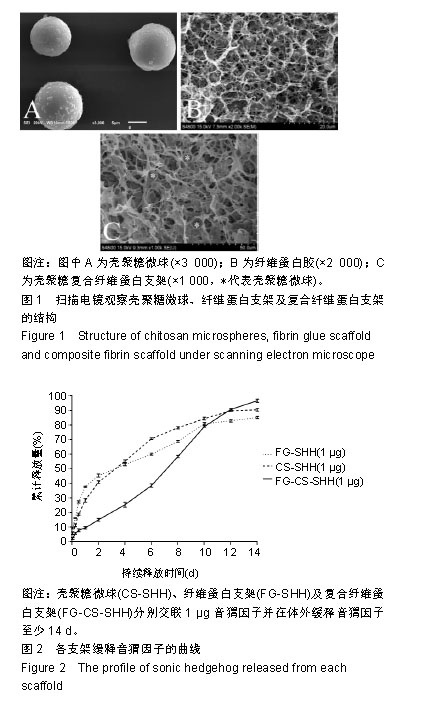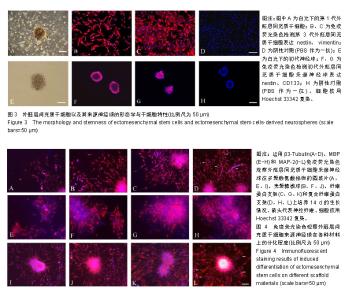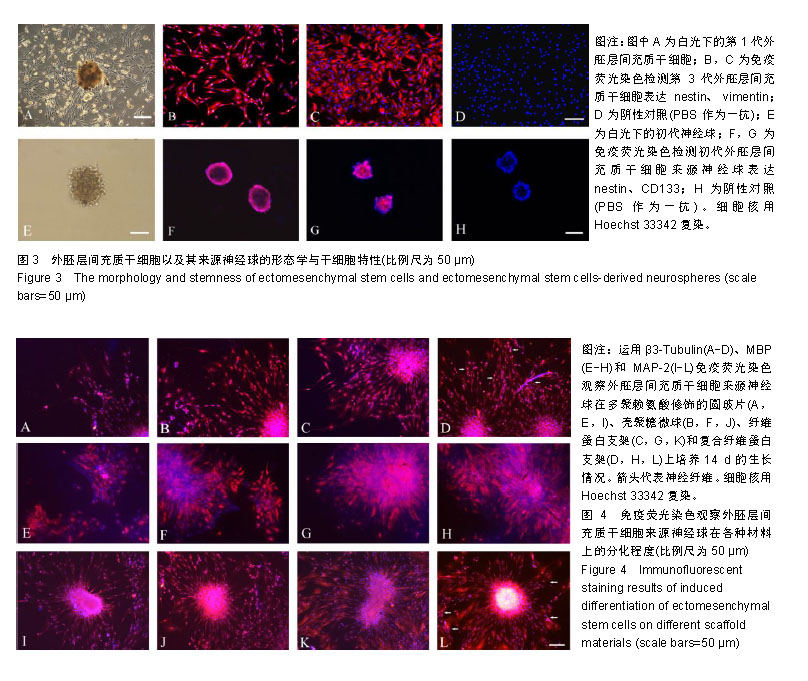| [1]Boido M, Garbossa D, Vercelli A. Early graft of neural precursors in spinal cord compression reduces glial cyst and improves function. J Neurosurg Spine. 2011;15(1):97-106.[2]胥少汀,郭世绂.脊髓损伤基础与临床[M].2版.北京:人民卫生出版社, 2002:350-452.[3]Riopel M, Trinder M, Wang R. Fibrin, a scaffold material for islet transplantation and pancreatic endocrine tissue engineering. Tissue Eng Part B Rev. 2015;21(1):34-44.[4]Sharp KG, Dickson AR, Marchenko SA, et al. Salmon fibrin treatment of spinal cord injury promotes functional recovery and density of serotonergic innervation. Exp Neurol. 2012; 235(1):345-356.[5]Spicer PP, Mikos AG. Fibrin glue as a drug delivery system. J Control Release. 2010;148(1):49-55.[6]Taylor SJ, Rosenzweig ES, McDonald JW 3rd, et al. Delivery of neurotrophin-3 from fibrin enhances neuronal fiber sprouting after spinal cord injury. J Control Release. 2006; 113(3):226-235.[7]Croisier F, Jérôme C. Chitosan-based biomaterials for tissue engineering. European Polymer Journal.2013;49(4):780-792.[8]Hu L, Sun Y, Wu Y. Advances in chitosan-based drug delivery vehicles. Nanoscale. 2013;5(8):3103-3111.[9]Hu XY,Zhang ZJ,Wang GY, et al. Preparation of Chitosan- Sodium Sodium Tripolyphosphate Nanoparticles via Reverse Microemulsion-Ionic Gelation Method. J Bionanoscience. 2015;9(4):301-305.[10]Bodnar M, Hartmann JF, Borbely J. Preparation and characterization of chitosan-based nanoparticles. Biomacromolecules. 2005;6(5):2521-2527.[11]Widera D, Zander C, Heidbreder M, et al. Adult palatum as a novel source of neural crest-related stem cells. Stem Cells. 2009;27(8):1899-1910.[12]Davies LC, Locke M, Webb RD, et al. A multipotent neural crest-derived progenitor cell population is resident within the oral mucosa lamina propria. Stem Cells Dev. 2010;19(6): 819-830.[13]贺清华,周月鹏,陈谦,等.大鼠鼻黏膜外胚层间充质干细胞向成骨细胞和神经元的诱导分化[J].江苏大学学报(医学版),2011,21(3): 190-194.[14]Yang WJ, Zhang JX, Cui XW, et al. Sonic Hedgehog Sustained Release from Sonic Hedgehog Chitosan Microspheres and Its Biocompatibility Study. Journal of Bionanoscience. 2016;10(1):69-72.[15]钟婧,洪艳,陈勇.壳聚糖季铵盐的最新研究进展[J].中国组织工程研究与临床康复, 2008,12(6):1115-1118.[16]Kwon JS, Kim GH, Kim DY, et al. Chitosan-based hydrogels to induce neuronal differentiation of rat muscle-derived stem cells. Int J Biol Macromol. 2012;51(5):974-979.[17]Orr MB, Gensel JC.Interactions of primary insult biomechanics and secondary cascades in spinal cord injury: implications for therapy.Neural Regen Res. 2017;12(10):1618-1619.[18]Totoiu MO, Keirstead HS. Spinal cord injury is accompanied by chronic progressive demyelination. J Comp Neurol. 2005; 486(4):373-383.[19]Liu J, Chen Q, Zhang Z, et al. Fibrin scaffolds containing ectomesenchymal stem cells enhance behavioral and histological improvement in a rat model of spinal cord injury. Cells Tissues Organs. 2013;198(1):35-46.[20]崔学文,张竞新,许艺荠,等. SHH缓释纤维蛋白支架移植促大鼠脊髓损伤的修复[J]. 神经解剖学,2017,33(2):131-137.[21]Yang Z, Zhang A, Duan H, et al. NT3-chitosan elicits robust endogenous neurogenesis to enable functional recovery after spinal cord injury. Proc Natl Acad Sci U S A. 2015;112(43): 13354-13359.[22]Ide C, Kanekiyo K.Points regarding cell transplantation for the treatment of spinal cord injury.Neural Regen Res. 2016;11(7): 1046-1049.[23]Yang Z, Duan H, Mo L, et al. The effect of the dosage of NT-3/chitosan carriers on the proliferation and differentiation of neural stem cells. Biomaterials. 2010;31(18):4846-4854.[24]Shea GK, Mok F.Optimization of nanofiber scaffold properties towards nerve guidance channel design.Neural Regen Res. 2018;13(7):1179-1180.[25]Chen Q, Zhang Z, Liu J, et al. A fibrin matrix promotes the differentiation of EMSCs isolated from nasal respiratory mucosa to myelinating phenotypical Schwann-like cells. Mol Cells. 2015;38(3):221-228.[26]Yu L, Gu T, Song L, et al. Fibrin sealant provides superior hemostasis for sternotomy compared with bone wax. Ann Thorac Surg. 2012;93(2):641-644.[27]Dudhaniabc AR, Kosarajua SL. Bioadhesive chitosan nanoparticles: Preparation and characterization. Carbohydrate Polymers. 2010; 81(2): 243-251.[28]Amidi M, Mastrobattista E, Jiskoot W, et al. Chitosan-based delivery systems for protein therapeutics and antigens. Adv Drug Deliv Rev. 2010;62(1):59-82.[29]Yang WJ, Zhang JX, He NY, et al. Investigation of Sonic Hedgehog Loading Chitosan /Sodium Tripolyphosphate Microspheres with Genipin as Cross-Linker. Journal of Bionanoscience. 2015; 9(5): 341-345.[30]Muzzarelli RA, El Mehtedi M, Bottegoni C, et al. Genipin- Crosslinked Chitosan Gels and Scaffolds for Tissue Engineering and Regeneration of Cartilage and Bone. Mar Drugs. 2015;13(12):7314-7338.[31]Delorme B, Nivet E, Gaillard J, et al. The human nose harbors a niche of olfactory ectomesenchymal stem cells displaying neurogenic and osteogenic properties. Stem Cells Dev. 2010; 19(6):853-866.[32]Wen X, Liu L, Deng M, et al. Characterization of p75(+) ectomesenchymal stem cells from rat embryonic facial process tissue. Biochem Biophys Res Commun. 2012;427(1): 5-10.[33]Zhang Z, He Q, Deng W, et al. Nasal ectomesenchymal stem cells: multi-lineage differentiation and transformation effects on fibrin gels. Biomaterials. 2015;49:57-67.[34]Yasuda H, Kuroda S, Shichinohe H, et al. Effect of biodegradable fibrin scaffold on survival, migration, and differentiation of transplanted bone marrow stromal cells after cortical injury in rats. J Neurosurg. 2010;112(2):336-344. |





